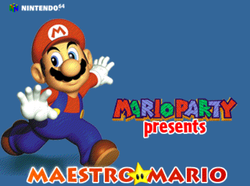Maestro Mario: Difference between revisions
No edit summary Tag: Mobile edit |
Apikachu68 (talk | contribs) m (Added lost template.) |
||
| (2 intermediate revisions by one other user not shown) | |||
| Line 1: | Line 1: | ||
{{lost|Much of the game's content is inaccessible, as the game required an internet connection to work.}} | |||
{{italic title}} | {{italic title}} | ||
{{game infobox | {{game infobox | ||
|image=[[File:MaestroMarioTitle.png|250px]] | |image=[[File:MaestroMarioTitle.png|250px]] | ||
|developer=[ | |developer=POP Multimedia<ref>[https://web.archive.org/web/20010105052900/http://www.popmultimedia.com/portfolio/websites/mario_content.html Mario section on the company's portfolio]. ''popmultimedia.com''. Archived from the original on January 5, 2001, 05:29:00 UTC via Wayback Machine. Retrieved July 15, 2023.</ref> | ||
|publisher=Nintendo | |publisher=[[Nintendo]] | ||
|release=1999 | |release=1999 | ||
|genre=Unknown | |genre=Unknown | ||
| Line 12: | Line 13: | ||
|input=Mouse | |input=Mouse | ||
}} | }} | ||
'''''Maestro Mario''''' | '''''Maestro Mario''''' is an {{wp|Adobe Shockwave}} game created to promote ''[[Mario Party]]'' for the [[Nintendo 64]]. It was playable from the game's official website alongside ''[[Mario's Memory Madness]]'' and ''[[Wario's Whack Attack]]'', which was eventually repurposed to promote later games in the [[Mario Party (series)|''Mario Party'' series]] as well. | ||
==Gameplay== | ==Gameplay== | ||
| Line 19: | Line 20: | ||
==Gallery== | ==Gallery== | ||
<gallery> | <gallery> | ||
MaestroMarioNameRegister.png|The name registration screen | |||
MaestroMarioWaitingForConnection.png|The game attempting to connect | |||
MaestroMarioConnectionError.png|The error screen after the game fails to connect | |||
</gallery> | </gallery> | ||
==References== | |||
<references/> | |||
{{MP}} | |||
{{Computer}} | {{Computer}} | ||
[[Category:Browser games]] | [[Category:Browser games]] | ||
[[Category:Mario Party]] | |||
Latest revision as of 20:53, January 26, 2025
This article is about a work that used to be available to the public, but is now partially or entirely inaccessible. Details: Much of the game's content is inaccessible, as the game required an internet connection to work.
Our documentation of the subject is inadequate. Only remove this notice if the complete work is recovered and made available publicly.
| Maestro Mario | |
|---|---|

| |
| Developer | POP Multimedia[1] |
| Publisher | Nintendo |
| Platform(s) | Browser |
| Release date | 1999[?] |
| Genre | Unknown |
| Rating(s) | N/A |
| Mode(s) | Single player |
| Format | Adobe Shockwave |
| Input | Mouse |
Maestro Mario is an Adobe Shockwave game created to promote Mario Party for the Nintendo 64. It was playable from the game's official website alongside Mario's Memory Madness and Wario's Whack Attack, which was eventually repurposed to promote later games in the Mario Party series as well.
Gameplay[edit]
Maestro Mario's content is mostly unknown, as the game breaks very soon after launching. The game boots up on a title screen for the program with a unique logo, which almost immediately cuts to a name registration screen at which Mario asks the player to tell him their name. The default text in the name registration box is "Modem." After the player registers a name, the game cuts to a screen with the text "Waiting for connection" on it. The connection always fails, cutting to an error screen that states that "There is no current connection."
Gallery[edit]
References[edit]
- ^ Mario section on the company's portfolio. popmultimedia.com. Archived from the original on January 5, 2001, 05:29:00 UTC via Wayback Machine. Retrieved July 15, 2023.


